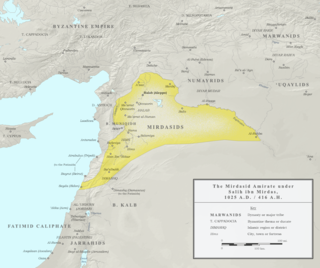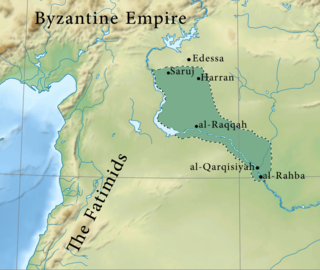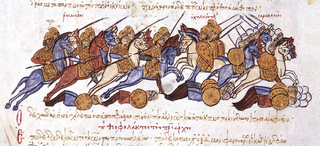Related Research Articles

Nikephoros II Phokas, Latinized Nicephorus II Phocas, was Byzantine emperor from 963 to 969. His career, not uniformly successful in matters of statecraft or of war, nonetheless greatly contributed to the resurgence of the Byzantine Empire during the 10th century. In the east, Nikephoros completed the conquest of Cilicia and retook the islands of Crete and Cyprus, opening the path for subsequent Byzantine incursions reaching as far as Upper Mesopotamia and the Levant; these campaigns earned him the sobriquet "pale death of the Saracens".

The Marwanids or Dustakids were a Kurdish Sunni Muslim dynasty in the Diyar Bakr region of Upper Mesopotamia and Armenia, centered on the city of Amid (Diyarbakır).

The Mirdasid dynasty, also called the Banu Mirdas, was an Arab Shia Muslim dynasty which ruled an Aleppo-based emirate in northern Syria and the western Jazira more or less continuously from 1024 until 1080.
John Kourkouas, also transliterated as Kurkuas or Curcuas, was one of the most important generals of the Byzantine Empire. His success in battles against the Muslim states in the East reversed the course of the centuries-long Arab–Byzantine wars and set the stage for Byzantium's eastern conquests later in the century.

ʿAlī ibn ʾAbū'l-Hayjāʾ ʿAbdallāh ibn Ḥamdān ibn Ḥamdūn ibn al-Ḥārith al-Taghlibī, more commonly known simply by his honorific of Sayf al-Dawla, was the founder of the Emirate of Aleppo, encompassing most of northern Syria and parts of the western Jazira.

The Battle of Raban was an engagement fought in autumn 958 near the fortress of Raban between the Byzantine army, led by John Tzimiskes, and the forces of the Hamdanid Emirate of Aleppo under the famed emir Sayf al-Dawla. The battle was a major victory for the Byzantines, and contributed to the demise of Hamdanid military power, which in the early 950s had proven a great challenge to Byzantium.

The Battle of Andrassos or Adrassos was fought on 8 November 960 between the Byzantines, led by Leo Phokas the Younger, and the forces of the Hamdanid Emirate of Aleppo under the emir Sayf al-Dawla. It was fought in an unidentified mountain pass in the Taurus Mountains.

Abu Muhammad al-Hasan ibn Abu'l-Hayja Abdallah ibn Hamdan al-Taghlibi, more commonly known simply by his honorific of Nasir al-Dawla, was the second Hamdanid ruler of the Emirate of Mosul, encompassing most of the Jazira.
Abu 'l-Ma'ali Sharif, more commonly known by his honorific title, Sa'd al-Dawla, was the second ruler of the Hamdanid Emirate of Aleppo, encompassing most of northern Syria. The son of the emirate's founder, Sayf al-Dawla, he inherited the throne at a young age and in the midst of a major offensive by the Byzantine emperor Nikephoros II Phokas that within two years conquered the western portions of his realm and turned Aleppo into a tributary state. Facing a multitude of rebellions and desertions until 977, Sa'd was unable even to enter his own capital, which was in the hands of his father's chief minister, Qarquya. By maintaining close relations with the Buyids, he managed to re-establish his authority in parts of the Jazira, but his rule was soon challenged by the rebellion of his governor Bakjur, who was supported by the Fatimids of Egypt. In turn, Sa'd came to rely increasingly on Byzantine assistance, although he continued to fluctuate in his allegiance between Byzantium, the Buyids, and the Fatimids.
Uddat al-Dawla Abu Taghlib Fadl Allah al-Ghadanfar al-Hamdani, usually known simply by his kunya as Abu Taghlib, was the third Hamdanid ruler of the Emirate of Mosul, encompassing most of the Jazira.
Melias was a Byzantine general of Armenian origin, active in the wars against the Arabs in the east under Nikephoros II Phokas and John I Tzimiskes. He was defeated before Amid in 973 by the Hamdanids and died in captivity shortly after.
Rashiq al-Nasimi was the governor of Tarsus for the Hamdanid emir Sayf al-Dawla and Abbasid caliph from 962 until the city's surrender to the Byzantine emperor Nikephoros II Phokas in 965. He then took over Antioch, and launched a failed attack on the Hamdanid capital, Aleppo in early 966. He took the lower city and besieged the citadel for over three months, but was killed and his men fled back to Antioch.
Bardas Parsakoutenos was a Byzantine commander and nephew of Emperor Nikephoros II Phokas.
Nikephoros Parsakoutenos was a Byzantine nobleman and nephew of Emperor Nikephoros II Phokas.

Sa'id ibn Hamdan was an early member of the Hamdanid dynasty who served as provincial governor and military leader under the Abbasid Caliphate. He was the father of the celebrated poet Abu Firas al-Hamdani.

The Numayrids were an Arab dynasty based in Diyar Mudar. They were emirs (princes) of their namesake tribe, the Banu Numayr. The senior branch of the dynasty, founded by Waththab ibn Sabiq in 990, ruled the Euphrates cities of Harran, Saruj and Raqqa more or less continuously until the late 11th century. In the early part of Waththab's reign, the Numayrids also controlled Edessa until the Byzantines conquered it in the early 1030s. In 1062, the Numayrids lost Raqqa to their distant kinsmen and erstwhile allies, the Mirdasids, while by 1081, their capital Harran and nearby Saruj were conquered by the Turkish Seljuks and their Arab Uqaylid allies. Numayrid emirs continued to hold isolated fortresses in Upper Mesopotamia, such as Qal'at an-Najm and Sinn Ibn Utayr near Samosata until the early 12th century, but nothing is heard of them after 1120.

The Byzantine conquest of Cilicia was a series of conflicts and engagements between the forces of the Byzantine Empire under Nikephoros II Phokas and the Hamdanid ruler of Aleppo, Sayf al-Dawla, over control of the region of Cilicia in southeastern Anatolia. Since the Muslim conquests of the 7th century, Cilicia had been a frontier province of the Muslim world and a base for regular raids against the Byzantine provinces in Anatolia. By the middle of the 10th century, the fragmentation of the Abbasid Caliphate and the strengthening of Byzantium under the Macedonian dynasty allowed the Byzantines to gradually take the offensive. Under the soldier-emperor Nikephoros II Phokas, with the help of the general and future emperor John I Tzimiskes, the Byzantines overcame the resistance of Sayf al-Dawla, who had taken control of the former Abbasid borderlands in northern Syria, and launched a series of aggressive campaigns that in 964–965 recaptured Cilicia. The successful conquest opened the way for the recovery of Cyprus and Antioch over the next few years, and the eclipse of the Hamdanids as an independent power in the region.

The Rebellion of Bardas Phokas the Younger was a major war within the Byzantine Empire, fought mostly in Asia Minor.
Qarghuyah or Qarquya was an important Arab administrator in the Hamdanid Dynasty under Sayf al-Dawla, who would go on to control Aleppo himself and even sign the Treaty of Safar with the Byzantine Empire as the ruling emir of Aleppo.

The sack of Aleppo in December 962 was carried out by the Byzantine Empire under Nikephoros Phokas. Aleppo was the capital of the Hamdanid emir Sayf al-Dawla, the Byzantines' chief antagonist at the time.